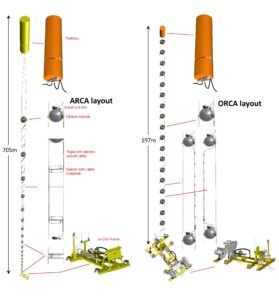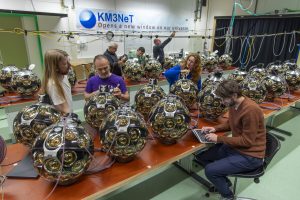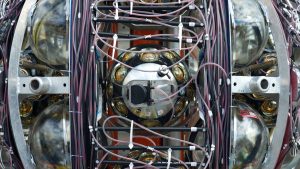The ARCA and ORCA detectors of the KM3NeT neutrino telescope are large 3D arrays of optical modules. The arrays are built from long vertical detections. The detection units are anchored to the seabottom and connected to a junction box in the subsea power and data transmission network of the ARCA or ORCA detector.
The KM3NeT detection unit – DU for short
A collection of 18 optical sensor modules connected by a thin custom designed electro-optical cable and supported by a vertical structure of two thin ropes is called a detection unit or DU for short. The glass vessel of each optical module module is surrounded by a titanium collar which allows for the module to be connected to two 4 mm diameter ropes made of Dyneema, a high strength manmade fibre. The ropes form the mechanical basis of a flexible support structure for the 18 modules. The two ropes are connected with an anchor, the weight of which keeps the detection unit firmly connected to the seabed. A top buoy is attached to keep the detection unit vertical in the sea currents.
The backbone cable
Attached to the ropes of the detection unit an electro-optical backbone cable runs the full length of the unit. It is a pressure balanced, oil-filled, plastic tube with a diameter of 4 mm that contains two copper wires for the power transmission (400 V DC) and 18 optical fibres for the data transmission. At the level of each optical module two power conductors and a single fibre are branched out via a breakout box. The breakout box also contains a DC/DC converter (400 V to 12 V). At the anchor the backbone cable is connected with the so-called base unit. In this unit the connection is made with the subsea electro-optical network which is connected to the control station on shore.
ARCA and ORCA
The main difference between the detection units for the ARCA and ORCA detectors is the length of the detection unit and consequently the spacing between optical modules attached to the unit. The difference reflects the difference in the scientific goals for which the detectors will be used. ARCA is optimised to detect cosmic neutrinos with a high energy of TeV-PeV while the spacing of ORCA is optimal for the detection of neutrinos with a lower energy of MeV-GeV.
Scientific paper
The prototype detection unit of the KM3NeT detector, KM3NeT Collaboration: S. Adrián-Martínez et al., Eur. Phys. J. C 76 (2016) 76:54




